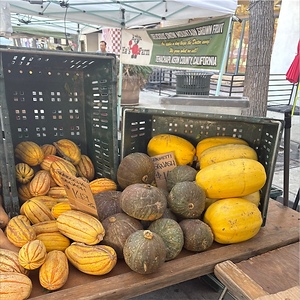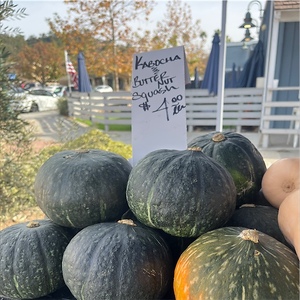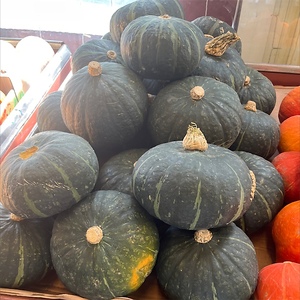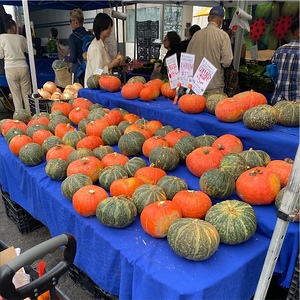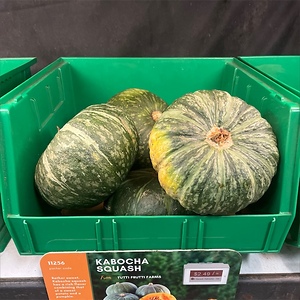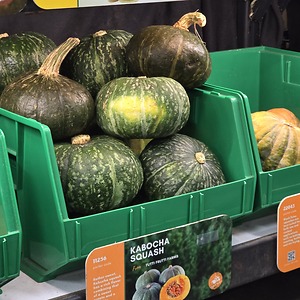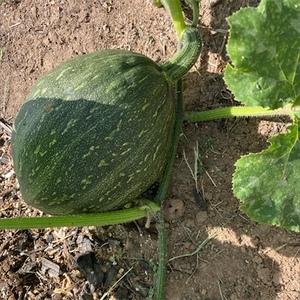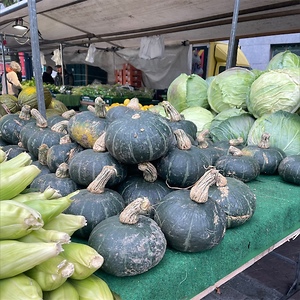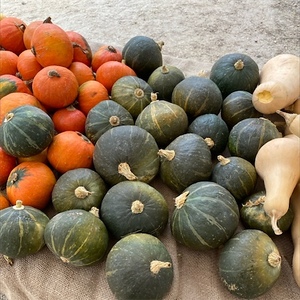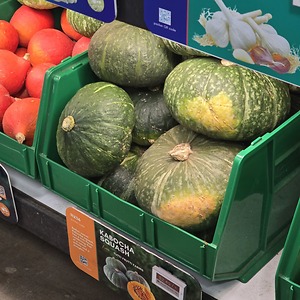


Kabocha Squash
Estimated Inventory, 40 lbs : 8.77
This item was last sold on : 07/13/25
Description/Taste
Kabocha squash varies in appearance but is commonly associated with having a medium size and textured dark green rind. This squash ranges from about 16 to 30.5 centimeters wide and weighs 1.5 to 2 kilograms each. It usually has a rounded flattened shape with a short cork-like light brown stem. The rind of Kabocha squash is typically dark green with thick light green ribbing. It’s often covered in large light green speckles or striations with occasional orange splotches. This rind is hard, thick, and dense with a dull finish and slightly knobbed texture. Kabocha squash flesh is spongy, dense, and has a deep yellow-orange hue. This flesh surrounds a central cavity filled with stringy pulp and many flat cream-colored seeds. When cooked Kabocha squash takes on a finely grained, dry, and tender texture. It has a rich, sweet, buttery, and nutty flavor reminiscent of sweet potato, pumpkin, and chestnut.
Seasons/Availability
Kabocha squash is available year-round with a peak season from fall to winter.
Current Facts
Kabocha squash is botanically classified as Cucurbita maxima and belongs to the Cucurbitaceae family along with gourds, pumpkins, and cucumbers. Kabocha has different implications depending on the regions it’s used in. In Japan, the word loosely translates to squash. It’s used to describe any squash variety found in Japan as well as Western pumpkin varieties. In English, it's often called Japanese squash and refers to a type of squash that typically originates from Japan. These varieties are most often associated with having a dark green hue, deep ribbing, and yellow-orange flesh but can also come in other colors. Kabocha squash is referred to by many other names around the world, including Buttercup pumpkin or Supermarket Squash in New Zealand, Danhobak in Korea, and Fak Thong in Thailand. Popular varieties that fall under the Kabocha squash umbrella include Ajihei, Ebisu, Emiguri, Marron d'Or, and Miyako squash.
Nutritional Value
Kabocha squash is a source of vitamins A, B1, B2, and C. These vitamins assist with immune support, eye and skin health, energy production, nerve and heart function, metabolism, cell growth and repair, iron absorption, and collagen production. They also help protect against inflammation and free radical damage. Kabocha squash contains calcium and fiber. These nutrients encourage muscle function, blood clotting, digestion, gut health, and managing blood sugar and cholesterol levels. Kabocha seeds can be dried and roasted to provide the body with protein that supports muscle growth and repair, keratin and collagen production, wound healing, and reduced cravings. Winter squashes like Kabocha can be used in Traditional Chinese Medicine to treat spleen and pancreas deficiencies. The juiced squash may also be applied topically to relieve burns and inflammation.
Applications
Kabocha squash is best suited for cooked applications such as roasting, steaming, sautéing, baking, frying, and braising. The hard shell of Kabocha squash can be a challenge to cut with a knife when uncooked. For ease of cutting the squash can first be microwaved for a few minutes to soften and then cooked with or without the skin. Kabocha squash holds its shape well when cooked and can be added in cubes to gratins, risottos, soups, stews, curries, and pasta. It can also be roasted on its own, combined with other root vegetables, and battered and fried tempura style or used in sushi. When cooked and puréed, it can be used to make bread, croquettes, desserts, cakes, and sauces. Kabocha squash pairs well with pears, apples, lemon, kale, spinach, eggplant, garlic, sage, parsley, shallots, cilantro, nutmeg, clove, curry spice, honey, brown sugar, coconut milk, butter, cream, Italian sausage, and parmesan cheese. It will keep for 1 to 3 months when stored in a cool and dry place. Once cut and deseeded they should be stored in the refrigerator where they can last up to a week.
Ethnic/Cultural Info
Kabocha squash has been traditionally consumed in Japan during the winter solstice since the Edo period. The squash is served with brown Adzuki beans to make a soup called shiruko. This sweet dish is made by boiling the beans with water and sugar and grilling them with mochi rice that floats in the bowl. In the Kyoto and Osaka regions of Japan this soup was made with the skin removed. Cooking shiruko at home was time-consuming so it was often sold in public tearooms called kanmi-dokoro or traded by peddlers who would carry the soup in wooden boxes on their backs. Instant versions of shiruko are now sold by many brands in Japan.
Geography/History
The dark green squash known to the English-speaking world as Kabocha was introduced to Japan by the Portuguese in the 1500s. It grows best in temperate to warm climates with sunny conditions and temperatures around 25 degrees Celcius during its germination season. Kabocha squash is a domesticated crop that’s grown in controlled environments like commercial farms and home gardens. It was brought to Japan on Portuguese ships in the mid-16th century during the Azuchi-Momoyama period. The squash was mistakenly thought to have come from Cambodia because that was the last place the explorers had visited. The Portuguese named the squash Cambodia abóbora which the Japanese renamed Nihon Kabocha. A similar looking squash with a sweeter taste and flakier texture was later introduced into Japan from the United States during the Edo period of the late 19th. This Western variety came to be known as the Seiyo kabocha and remains one of the most popular squashes in Japan. Kabocha squash is widely available throughout Japan. It’s also commonly found at farmers' markets and specialty grocers across Asia, Europe, Africa, Australia, South America, and North America. Its seeds can be purchased for growing in home gardens.
Featured Restaurants
Restaurants currently purchasing this product as an ingredient for their menu.
| Blue Ocean | Carlsbad CA | 760-434-4959 |
| Viejas Casino Grove Steakhouse | Alpine CA | 800-295-3172 |
| Azuki Sushi Lounge | San Diego CA | 619-238-4760 |
| The Santaluz Club Inc - Banquet | San Diego CA | 858-759-3150 |
| Sushi Kami | San Diego CA | 858-451-7799 |
| The Bowl | San Diego CA | 619-813-5865 |
| Secret Sister | San Diego CA | 619-281-0718 |
| Campfire Bar | Carlsbad CA | 858-231-0862 |
| Moment Sushi | San Diego CA | 858-230-6268 |
| The Joint | San Diego CA | 619-222-8272 |
| Herb & Wood | San Diego CA | 520-205-1288 |
| InterContinental Vistal Kitchen | San Diego CA | 619-501-9400 |
| Shimbashi Izakaya | Del Mar CA | 858-523-0479 |
| Sushi Tadokoro | San Diego CA | 619-347-2792 |
| The Lion Share 2025 | San Diego CA | 619-564-6924 |
| The Plot Restaurant (Costa Mesa) | Costa Mesa CA | 714-852-3181 |
| Reata Glen | Ladera Ranch CA | 949-545-2250 |
| Pitchers | San Diego CA | 858-472-1251 |
| Kairoa Brewing Company | San Diego CA | 858-735-0051 |
| Blue Ocean Sushi & Grill (UTC) | San Diego CA | 858-886-9909 |
| Tahona (Kitchen) | San Diego CA | 619-573-0289 |
| Ju-Ichi | San Diego CA | 619-800-2203 |
| Le Papagayo (Encinitas) | Encinitas CA | 760-944-8252 |
| Kappa Sushi | San Diego CA | 858-566-3388 |
Recipe Ideas
Recipes that include Kabocha Squash. One



